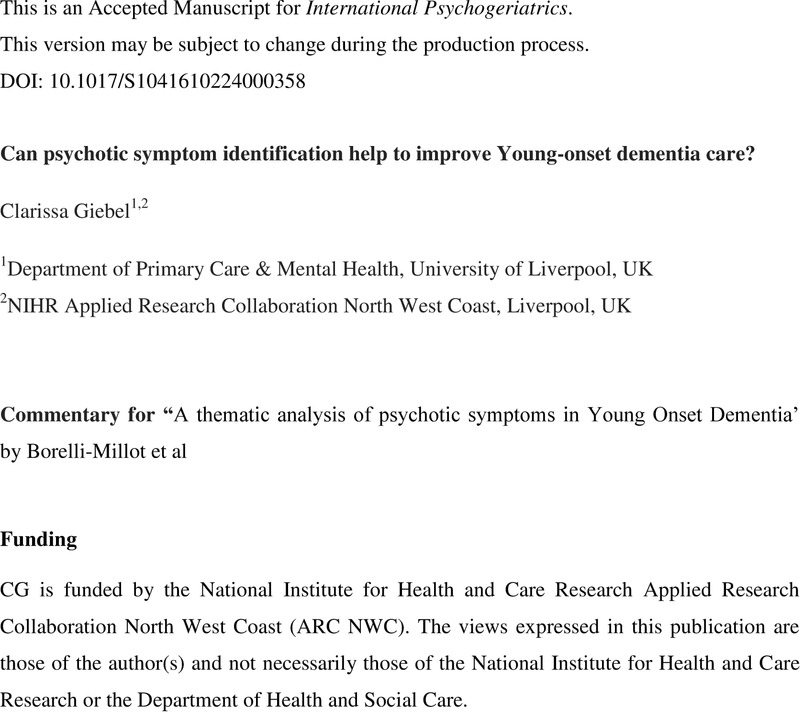No CrossRef data available.
Article contents
Can psychotic symptom identification help to improve young-onset dementia care?
Commentary on “A thematic analysis of psychotic symptoms in young-onset dementia” by Borelli-Millot et al.
Published online by Cambridge University Press: 08 February 2024
Abstract
An abstract is not available for this content so a preview has been provided. Please use the Get access link above for information on how to access this content.

- Type
- Commentary
- Information
- Copyright
- © The Author(s), 2024. Published by Cambridge University Press on behalf of International Psychogeriatric Association
References
Appelhof, B., Bakker, C., Van Duinen-van Den IJssel, J. C. L., Zwijsen, S. A., Smalbrugge, M., Verhey, F. R. J., de Vugt, M. E., Zuidema, S. U., & Koopmans, R. T. C. M. (2019). Differences in neuropsychiatric symptoms between nursing home residents with young-onset dementia and late-onset dementia. Aging & Mental Health, 23(5), 581–586.Google Scholar
Bauhuis, R., Mulders, A. J. M. J., & Koopmans, R. T. C. M. (2020). The course of neuropsychiatric symptoms in institutionalized patients with young onset dementia. Aging & Mental Health, 24(3), 439–444.Google Scholar
Borelli-Millott, L. F., Loi, S. M., Velakoulis, D., & Goh, A. M. Y. (2024). A thematic analysis of psychotic symptoms in young onset dementia. International Psychogeriatrics, 1–9.Google Scholar
Geraudine, A., Battista, P., & Garcia, A. M. (2021). Speech and language impairments in behavioral variant frontotemporal dementia: A systematic review. Neuroscience & Biobehavioral Reviews, 131, 1076–1095.Google Scholar
Giebel, C., Cations, M., Draper, B., & Komuravelli, A. (2023). Ethnic disparities in the uptake of anti-dementia medication in young and late-onset dementia. International Psychogeriatrics, 35(7), 381–390.Google Scholar
Giebel, C. M., Sutcliffe, C., Stolt, M., Karlsson, S., Renom-Guiteras, A., Soto, M., Verbeek, H., Zabalegui, A., & Challis, D. (2014). Deterioration of basic activities of daily living and their impact on quality of life across different cognitive stages of dementia: A European study. International Psychogeriatrics, 26(8), 1283–1293.Google Scholar
Greenwood, N., & Smith, R. (2016). The experiences of people with young-onset dementia: A meta-ethnographic review of the qualitative literature. Maturitas, 92, 102–109.Google Scholar
Jøranson, N., Olsen, C., Calogiuri, G., Ihlebæk, C., & Pedersen, I. (2021). Effects on sleep from group activity with a robotic seal for nursing home residents with dementia: A cluster randomized controlled trial. International Psychogeriatrics, 33(10), 1045–1056.Google Scholar
Matar, E., Ehgoetz Martens, K. A., Halliday, G. M., & Lewis, S. J. G. (2020). Clinical features of Lewy body dementia: Insights into diagnosis and pathophysiology. Journal of Neurology, 267(2), 380–389.Google Scholar
Perry, M., Michgelsen, J., Timmers, R., Peetoom, K., Koopmans, R., & Bakker, C. (2024). Perceived barriers and solutions by generalist physicians to work towards timely young-onset dementia diagnosis. Aging & Mental Health, 28(2), 262–267.Google Scholar
Vik-Mo, A. O., Giil, L. M., Borda, M. G.án, Ballard, C., & Aarsland, D. (2020). The individual course of neuropsychiatric symptoms in people with Alzheimer’s and Lewy Body dementia: 12-year longitudinal cohort study. The British Journal of Psychiatry, 216(1), 43–48.Google Scholar
Wallace, L., Hunter, S., Theou, O., Fleming, J., Rockwood, K., & Brayne, C. (2021). Frailty and neuropathology in relation to dementia status: The Cambridge City over-75s Cohort study. International Psychogeriatrics, 33(10), 1035–1043.Google Scholar
World Health Organisation. Dementia Factsheet. World Health Organisation 2023. Accessed February 1, 2024. https://www.who.int/news-room/fact-sheets/detail/dementia#:~:text=Currently more than 55 million,injuries that affect the brain.Google Scholar


